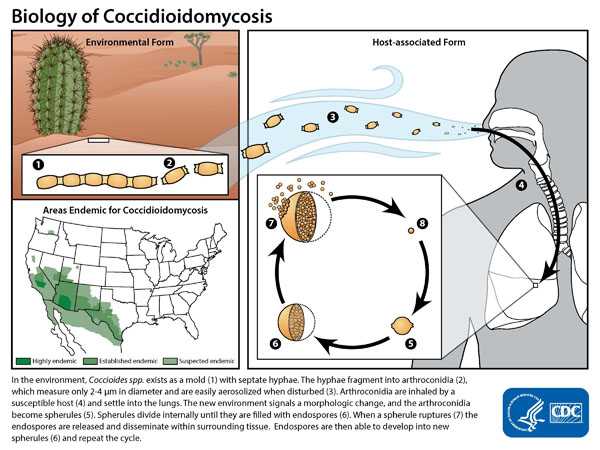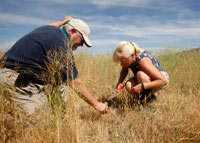Sources of Valley Fever (Coccidioidomycosis)
Where does Coccidioides live?

This map is based on studies performed in the late 1940s and 1950s and also on locations of more recent outbreaks and cases. Coccidioides might also live in similar areas with hot, dry climates that are not shaded on the map.
Coccidioides lives in dust and soil in some areas in the southwestern United States, Mexico, and South America. In the United States, Coccidioides lives in Arizona, California, Nevada, New Mexico, Texas, and Utah. The fungus was also recently found in south-central Washington.1
This map shows the approximate areas (called “endemic areas”) where Coccidioides is known to live or is suspected to live in the U.S. and Mexico.1–6 Much of what is known about where the fungus lives in the southwestern U.S. is based on studies performed in the late 1940s and early 1950s.2 The map also shows the locations of several outbreaks and locations of Valley fever cases acquired outside of the areas identified by skin testing. Coccidioides might also live in similar areas with hot, dry climates that are not shaded on the map.
Life cycle of Coccidioides
Coccidioides spores circulate in the air after contaminated soil and dust are disturbed by humans, animals, or the weather. The spores are too small to see without a microscope. When people breathe in the spores, they are at risk for developing Valley fever. After the spores enter the lungs, the person’s body temperature allows the spores to change shape and grow into spherules. When the spherules get large enough, they break open and releases smaller pieces (called endospores) which can then potentially spread within the lungs or to other organs and grow into new spherules.
Click here for the PDF version of image [PDF – 1 page] for printing.

Uncommon sources of Valley fever
The most common way for someone to get Valley fever is by inhaling Coccidioides spores that are in the air. In extremely rare cases, people can get the infection from other sources, such as:
Testing soil

Testing soil for Coccidioides is sometimes done as a research activity. Here, Thomas Mace, senior scientific adviser to NASA, helps Cal State Bakersfield microbiologist Antje Lauer collect soil samples in Central CA to test for Coccidioides . Credit: Shelby Mack/ The Bakersfield Californian.
I’m worried that Coccidioides is in the soil near my home. Can someone test the soil to find out if the fungus is there?
No, in this situation, testing soil for Coccidioides isn’t likely to be useful because the fungus is thought to be common in the soil in certain areas. A soil sample that tests positive for Coccidioides doesn’t necessarily mean that the soil will release the fungus into the air and cause infection. Also, there are no commercially-available tests to detect Coccidioides in soil. Testing soil for Coccidioides is currently only done for scientific research.
Testing soil for research
Scientists sometimes test soil or other environmental samples for Coccidioides to understand more about its habitat and how weather or climate patterns may affect its growth. The available methods to detect Coccidioides in the soil don’t always detect Coccidioides spores even if they are present. However, new tests are being developed so that researchers can better detect Coccidioides in the environment.
Click here to learn more about how CDC is using advanced molecular detection (AMD) methods to better understand the geographic distribution of Coccidioides.
Valley fever and the weather
Scientists continue to study how weather and climate patterns affect the habitat of the fungus that causes Valley fever. Coccidioides is thought to grow best in soil after heavy rainfall and then disperse into the air most effectively during hot, dry conditions.11 For example, hot and dry weather conditions have been shown to correlate with an increase in the number of Valley fever cases in Arizona12 and in California (but to a lesser extent).13 The ways in which climate change may be affecting the number of Valley fever infections, as well as the geographic range of Coccidioides, isn’t known yet, but is a subject for further research.
References
- Marsden-Haug N, Goldoft M, Ralston C, Limaye AP, Chua J, Hill H, et al. Coccidioidomycosis acquired in Washington State. Clin Infect Dis. 2013 Mar;56(6):847-50.
- Edwards PQ, Palmer CE. Prevalence of sensitivity to coccidioidin, with special reference to specific and nonspecific reactions to coccidioidin and to histoplasmin. Diseases of the chest. 1957 Jan;31(1):35-60.
- Werner SB, Pappagianis D. Coccidioidomycosis in Northern California. An outbreak among archeology students near Red Bluff. California medicine. 1973 Sep;119(3):16-20.
- Werner SB, Pappagianis D, Heindl I, Mickel A. An epidemic of coccidioidomycosis among archeology students in northern California. N Engl J Med. 1972 Mar 9;286(10):507-12.
- Petersen LR, Marshall SL, Barton-Dickson C, Hajjeh RA, Lindsley MD, Warnock DW, et al. Coccidioidomycosis among workers at an archeological site, northeastern Utah. Emerg Infect Dis. 2004 Apr;10(4):637-42.
- Hector RF, Laniado-Laborin R. Coccidioidomycosis–a fungal disease of the Americas. PLoS medicine. 2005 Jan;2(1):e2.
- Dierberg KL, Marr KA, Subramanian A, Nace H, Desai N, Locke JE, et al. Donor-derived organ transplant transmission of coccidioidomycosis. Transpl Infect Dis. 2012 Jun;14(3):300-4.
- Eckmann BH, Schaefer GL, Huppert M. Bedside Interhuman Transmission of Coccidioidomycosis Via Growth on Fomites. An Epidemic Involving Six Persons. Am Rev Respir Dis. 1964 Feb;89:175-85.
- Dweik M, Baethge BA, Duarte AG. Coccidioidomycosis pneumonia in a nonendemic area associated with infliximab. South Med J. 2007 May;100(5):517-8.
- Stagliano D, Epstein J, Hickey P. Fomite-transmitted coccidioidomycosis in an immunocompromised child. Ped Infect Dis J. 2007 May;26(5):454-6.
- Smith CE, Beard RR, et al. Effect of season and dust control on coccidioidomycosis. JAMA. 1946 Dec 7;132(14):833-8.
- Park BJ, Sigel K, Vaz V, Komatsu K, McRill C, Phelan M, et al. An epidemic of coccidioidomycosis in Arizona associated with climatic changes, 1998-2001. J Infect Dis. 2005 Jun 1;191(11):1981-7.
- Zender CS, Talamantes J. Climate controls on valley fever incidence in Kern County, California. Int J Biometerol. 2006 Jan;50(3):174-82.
- Page last reviewed: January 27, 2017
- Page last updated: August 3, 2017
- Content source:


 ShareCompartir
ShareCompartir